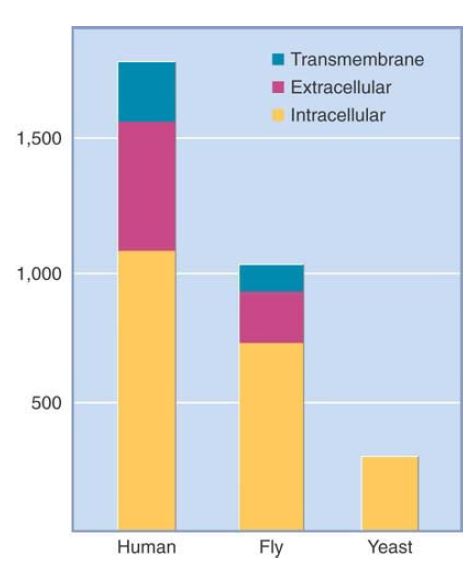
Morphological Complexity Evolves by Adding New Gene Functions
 المؤلف:
JOCELYN E. KREBS, ELLIOTT S. GOLDSTEIN and STEPHEN T. KILPATRICK
المؤلف:
JOCELYN E. KREBS, ELLIOTT S. GOLDSTEIN and STEPHEN T. KILPATRICK
 المصدر:
LEWIN’S GENES XII
المصدر:
LEWIN’S GENES XII
 الجزء والصفحة:
الجزء والصفحة:
 16-3-2021
16-3-2021
 2901
2901
Morphological Complexity Evolves by Adding New Gene Functions
KEY CONCEPTS
-In general, comparisons of eukaryotes to prokaryotes, multicellular to unicellular eukaryotes, and vertebrate to invertebrate animals show a positive correlation between gene number and morphological complexity as additional genes are needed with generally increased complexity.
-Most of the genes that are unique to vertebrates are involved with the immune or nervous systems.
Comparison of the human genome sequence with sequences found in other species is revealing about the process of evolution.
FIGURE 1. shows an analysis of human genes according to the breadth of their distribution among all cellular organisms. Beginning with the most generally distributed (upper-right corner of the figure), about 21% of genes are common to eukaryotes and prokaryotes. These tend to encode proteins that are essential for all living forms—typically basic metabolism, replication, transcription, and translation. Moving clockwise, another approximately 32% of genes are found in eukaryotes in general— for example, they can be found in yeast. These tend to encode proteins involved in functions that are general to eukaryotic cells but not to bacteria—for example, they might be concerned with the activities of organelles or cytoskeletal components. Another approximately 24% of genes are generally found in animals. These include genes necessary for multicellularity and for development of different tissue types. Approximately 22% of genes are unique to vertebrate animals. These mostly encode proteins of the immune and nervous systems; they encode very few enzymes, consistent with the idea that enzymes have ancient origins, and that metabolic pathways originated early in evolution. Therefore, we see that the evolution of more complex morphology and specialization requires
the addition of groups of genes representing the necessary new functions.

FIGURE 1. Human genes can be classified according to how widely their homologs are distributed in other species.
One way to define essential proteins is to identify the proteins present in all proteomes. Comparing the human proteome in more detail with the proteomes of other organisms, 46% of the yeast proteome, 43% of the worm proteome, and 61% of the fruit fly proteome are represented in the human proteome. A key group of about 1,300 proteins is present in all four proteomes. The common proteins are basic “housekeeping” proteins required for essential functions, falling into the types summarized in FIGURE 2. The main functions are transcription and translation (35%), metabolism (22%), transport (12%), DNA replication and modification (10%), protein folding and degradation (8%), and cellular processes (6%), with the remaining 7% dedicated to various other functions.

FIGURE 2. Common eukaryotic proteins are involved with essential cellular functions.
One of the striking features of the human proteome is that it has many unique proteins compared with those of other eukaryotes but has relatively few unique protein domains (portions of proteins having a specific function). Most protein domains appear to be common to the animal kingdom. However, there are many unique protein architectures, defined as unique combinations of domains.
FIGURE .3 shows that the greatest proportion of unique proteins consists of transmembrane and extracellular proteins. In yeast, the majority of architectures are associated with intracellular proteins.
There are about twice as many intracellular architectures in fruit flies (or nematode worms), but there is a strikingly higher proportion of transmembrane and extracellular proteins, as might be expected from the additional functions required for the interactions between the cells of a multicellular organism. The additions in intracellular architectures required in a vertebrate
(typified by the human genome) are relatively small, but there is, again, a higher proportion of transmembrane and extracellular architectures.

FIGURE .3 Increasing complexity in eukaryotes is accompanied by accumulation of new proteins for transmembrane and extracellular functions.
It has long been known that the genetic difference between humans and chimpanzees (our nearest relative) is very small, with 98.5% identity between genomes. The sequence of the chimpanzee genome now allows us to investigate the 1.5% of differences in more detail to see whether features responsible for “humanity” can be identified. (Genome sequences for the nonhuman primates orangutan and gorilla as well as the Paleolithic human species of Neanderthals and Denisovans are also now available for comparison.) The comparison shows 35 × 106 nucleotide substitutions (1.2% sequence difference overall), 5 × 106 deletions or insertions (making about 1.5% of the euchromatic sequence specific to each species), and many chromosomal rearrangements.
Homologous proteins are usually very similar: 29% are identical, and in most cases there are only one or two amino acid differences between the species in the protein. In fact, nucleotide substitutions occur less often in genes encoding polypeptides than are likely to be involved in specifically human traits, suggesting that protein evolution is not a major factor in human–chimpanzee differences.
This leaves larger-scale changes in gene structure and/or changes in gene regulation as the major candidates. Some 25% of nucleotide substitutions occur in CpG dinucleotides (among which are many potential regulator sites).
 الاكثر قراءة في مواضيع عامة في الاحياء الجزيئي
الاكثر قراءة في مواضيع عامة في الاحياء الجزيئي
 اخر الاخبار
اخر الاخبار
اخبار العتبة العباسية المقدسة


